What Laws Must be Added to Your Employee Handbook
Chances are you’re on the hunt to make your employee handbook a genuine guide that protects your team and your business, not just a snooze-fest of dos and don’ts. This ideal handbook goes beyond rigid rules; it’s a dynamic guide that reflects your company’s mission and values and supports your employees.
Why does it matter? Aside from shielding your company against legal disputes, a well-constructed handbook indicates that your company isn’t just going through the motions of legal compliance. It tells your team that their rights matter, they’re working in a company with purpose that respects and honors those rights, and it ensures everyone’s on the same page about what’s cool and what’s not at work.
Stick with us as we walk you through the required laws for your handbook, ensuring you’re ticking all the legal boxes while also keeping things approachable and relatable for your team of non-lawyer humans. Your handbook shouldn’t just be legally compliant; it should be a user-friendly resource that everyone in your company understands and values.
Policies vs. Laws
When it comes to your employee handbook, policies and laws are intertwined and they’re both crucial.
Although many laws in the US, including state laws, do not demand that you have a specific policy, they often require that you provide notice to employees about the law, sometimes within a specific time period such as when an employee starts and on an annual basis after that.
There are different ways to provide notice. One method is to follow the lead of labor law posters, like those for minimum wage or job safety that are commonly displayed in areas like break rooms. There are posters for other laws too! However, since you don’t have unlimited wall space, the most common way to disseminate this information is through an employee handbook. This is one of the biggest reasons why companies have policies. They educate employees on how they need to act in order to comply with the law and also give notice about their specific rights underneath the law.
Employment laws relate to topics like employee rights, safety standards, and workplace conditions, among others. In addition to helping companies comply with notice requirements for these specific laws, many companies also develop policies to cater to their specific needs, values, and culture. They often detail codes of conduct, use of company property, punctuality, and other “how things work around here” topics that help inform employees of what is expected of them in their workspace.
Policies connect employees in a shared duty where everyone is informed, understands their role, and contributes to a workplace that’s not only lawful but also open and fair.
Why Should Your Policies Cover Employment Laws?
The main reason is that most employment laws have a notice requirement. It’s most efficient to package all these notices together into a single document, known as an employee handbook. This handbook is typically distributed to new employees when they start, and thereafter once per year to everyone.
Here are the main laws your policies should cover:
- Anti-discrimination and harassment laws – These are foundational to any workplace. It’s essential for policies to reflect a zero-tolerance approach to any form of discrimination or harassment.
- Equal Employment Opportunity (EEO) Laws – Having these laws in place makes sure everyone gets treated fairly in every part of their employment and keeps the work environment bias-free.
- Wage and hour laws – These laws provide clear guidelines regarding pay, overtime, and work hours, making sure every moment of work is recognized and compensated.
- Workplace safety – Sticking to health and safety regulations is a must-do to create a workspace that follows the rules and keeps everyone safe and sound.
- Family and Medical Leave Act (FMLA) and other leave laws – Life can be unpredictable, and the workplace needs to reflect this reality. This law sets the directions for how employees can take unpaid, job-protected leaves for certain family and medical situations, which can offer some peace of mind.
- Employee Benefits – As the modern workplace evolves, so do the perks and benefits offered. It’s super important to create policies that make the legalities of offering and managing all the different employee perks and benefits clear and straightforward.
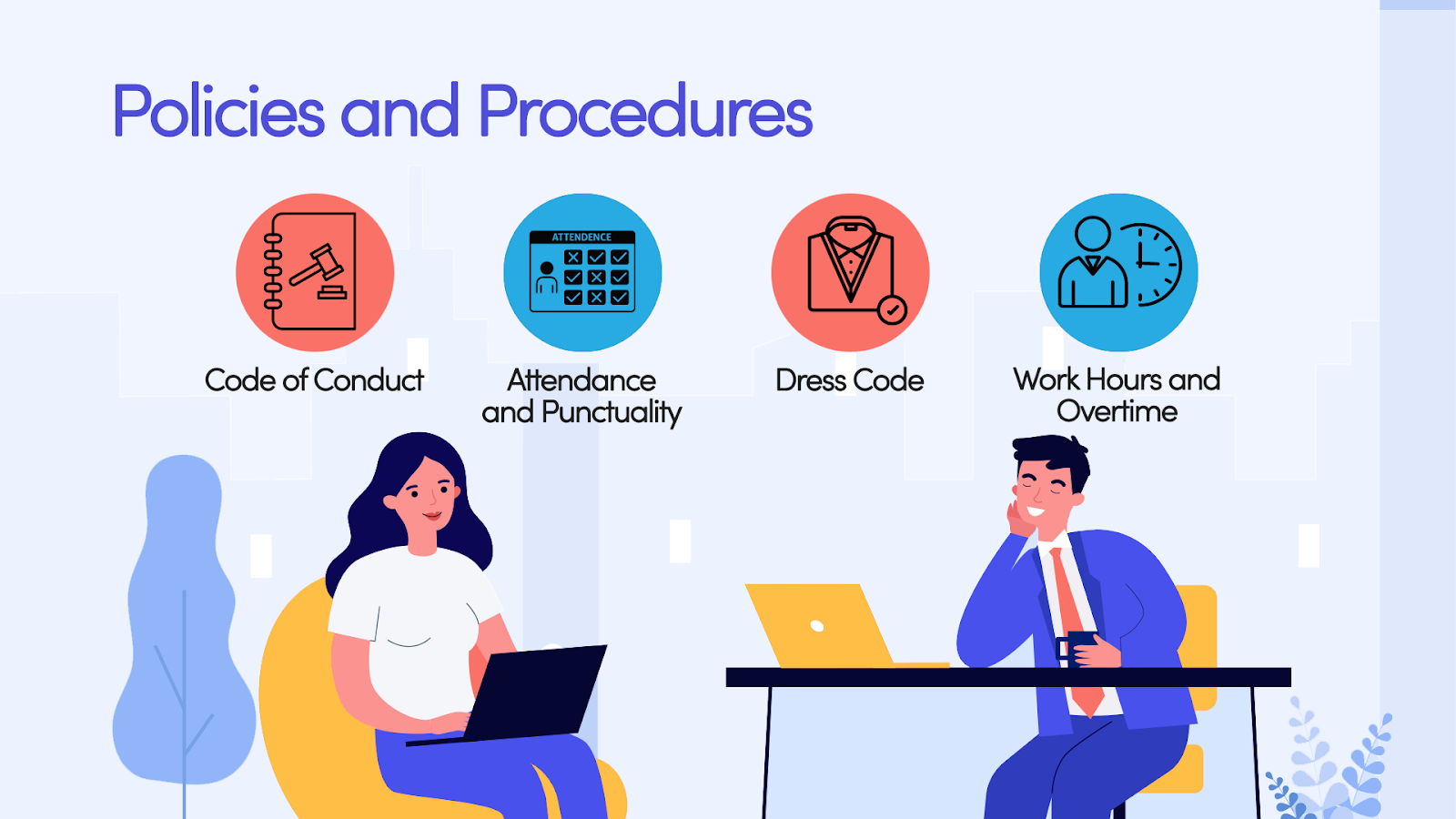
Employee Handbook Policies and the Laws They Cover
Let’s go deeper into each of the employment laws that the policies in your handbook should cover.
Anti-discrimination and Equal Employment Opportunity (EEO) laws
Your policies on anti-discrimination, anti-harassment, and EEO aren’t just nice-to-haves – they’re must-haves, both for treating people right and for staying on the right side of the law.
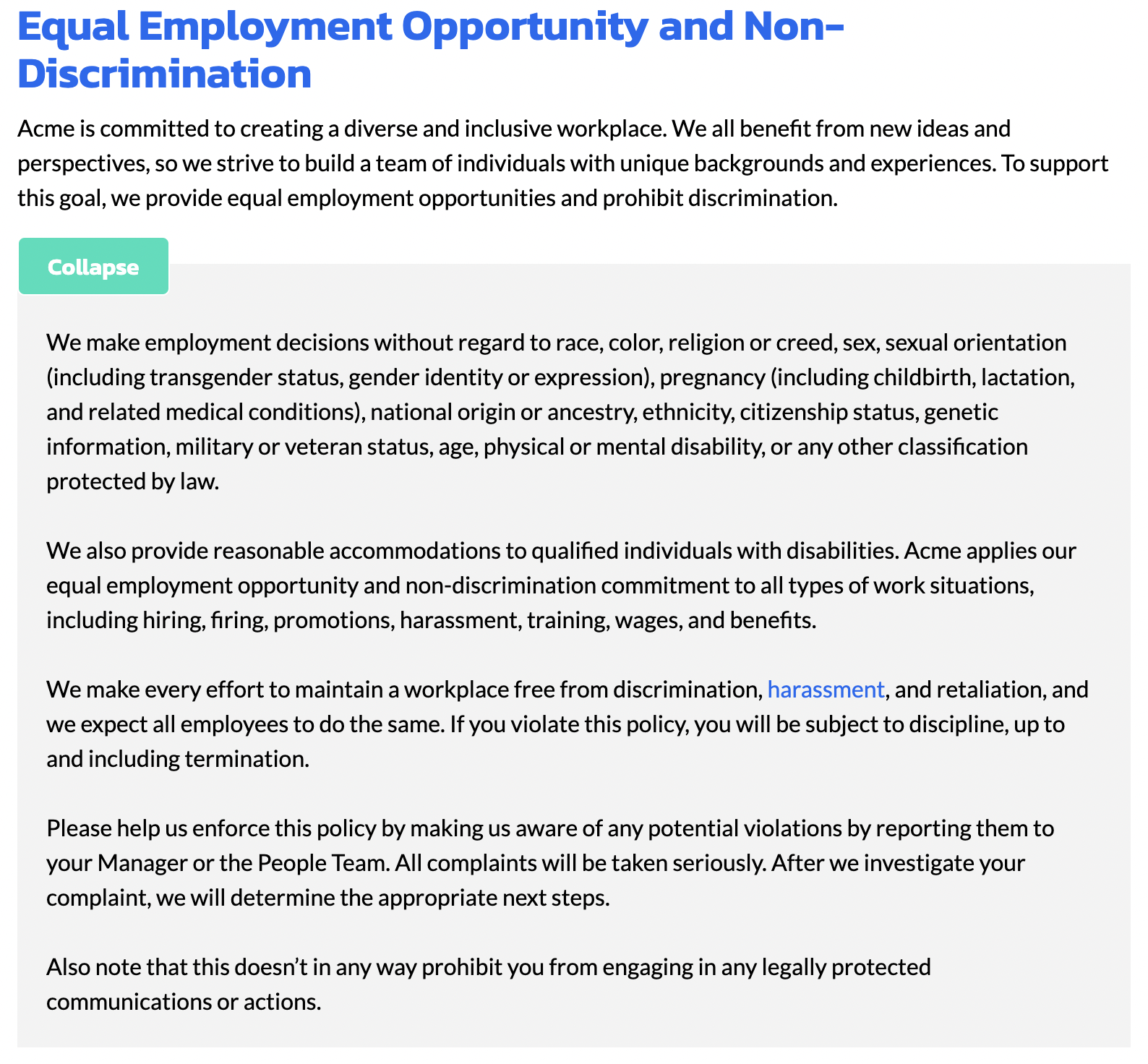
Title VII of the Civil Rights Act of 1964
This federal law states that everyone should be treated equally at work, no matter their race, color, religion, sex, or where they’re from. It’s all about making sure every person gets the same chances for promotions and recognitions without any bias. Employees should be able to work hard and get fair recognition without worrying about being treated unfairly.
Americans with Disabilities Act (ADA)
This federal law is all about making work doable and accessible for everyone, even those with disabilities. Employers are required to make reasonable accommodations to make sure all employees can do their jobs and navigate their workspaces without unnecessary hurdles, so every US citizen has the opportunity to earn a living.
Age Discrimination in Employment Act (ADEA)
This one protects the more experienced folks in the workplace: those who are 40 and above. It ensures older employees are treated fairly, giving them the opportunity to share their skills and wisdom without worrying about not getting equal treatment solely because of their age.
Pregnant Workers Fairness Act
In the last year, there’s been a movement to protect pregnant workers and the result was the Pregnant Workers Fairness Act. This makes sure expecting parents are also protected and not discriminated against. Pregnant employees are required to get a minimum amount of support at work. It makes it easier for career-driven employees to also prioritize starting a family, reducing stress during such an essential time in their lives.
Employment relationship laws
In the workplace, employers and employees both need to understand their rights, duties, and expectations. Employment relationship laws come into play to ensure both the employer and the employee play fair and square.
These laws govern how employers and employees interact in the workplace, defining what employers can expect from employees and vice versa. It also helps build trust with employees, showing that the organization values a balanced and transparent working relationship.
At-will employment doctrine
The at-will employment doctrine lets employers and employees end their working relationship anytime they want and for any reason, as long as it’s not illegal. Employers can manage their team sizes as needed, while employees have the liberty to leave a job whenever they wish, offering flexibility on both ends.
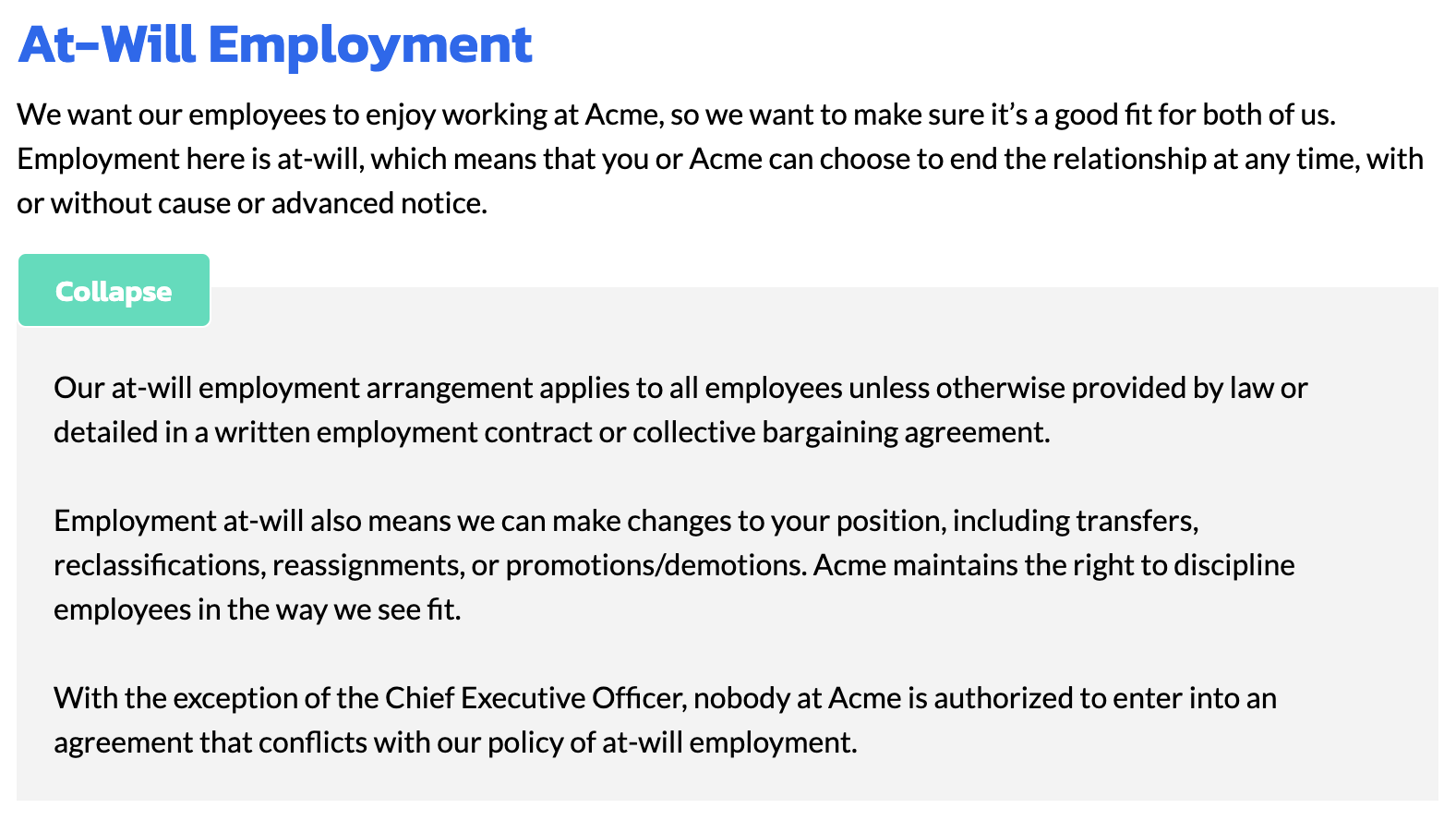
This is why it’s important to make it clear that the employee handbook is not an employment contract. To emphasize that, avoid including items such as non-competes, non-disclosure agreements (NDAs), or any policy that might unintentionally alter the at-will employment status.
Clarify a handbook’s purpose and limit by inserting a disclaimer at the beginning of your handbook. But remember, setting a friendly and welcoming tone from the start is equally important. Introduce the disclaimer in a separate section, perhaps under an unassuming and non-confrontational heading like “About This Handbook.” This approach ensures clarity without compromising on establishing a positive initial engagement with the employees.
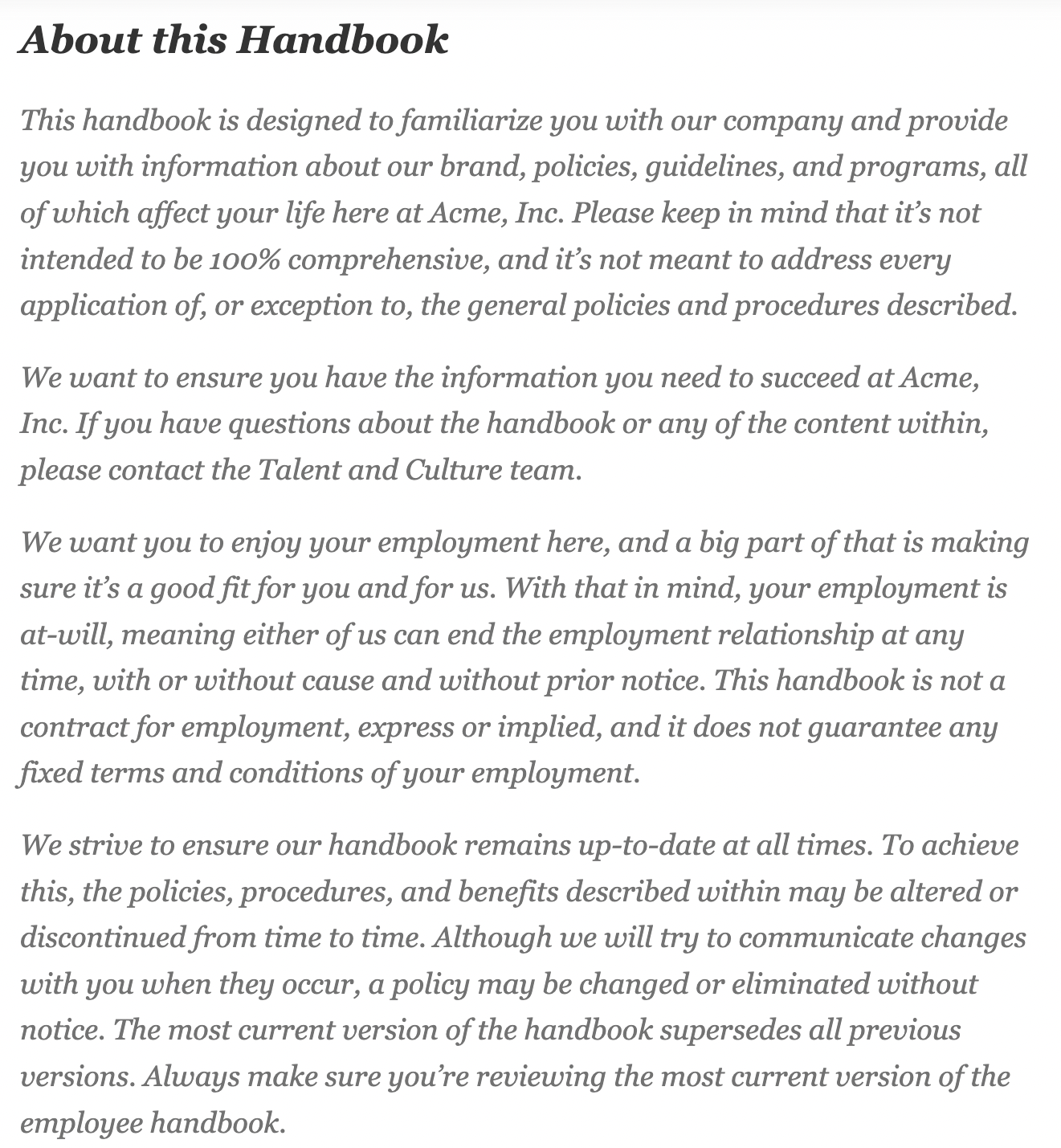
Exceptions to at-will employment
Aside from Montana, all US states adhere to the at-will employment law, though there are a few exceptions in some states. Exceptions might involve contracts that define specific employment terms, or rules that prevent unfair terminations, such as firing someone to avoid paying them a deserved bonus. These exceptions offer a layer of protection to employees and provide legal guidelines for employers on when and how terminations can occur.
More detailed information about exceptions and modifications to the doctrine can be found in this How to Write a Disclaimer for your Employee Handbook article.
State-specific termination laws
Different states impose different rules; for example, some require a notice period before an employee is dismissed, while others require employers to provide termination reasons.
An example is California. Although the at-will employment doctrine is recognized, there are numerous protective layers for employees to prevent wrongful terminations. For example, employers cannot terminate someone for discriminatory reasons, which would be a violation of the Equal Employment Opportunity (EEO) laws. California also provides whistleblowers with strong protection, meaning employers cannot terminate employees who have reported illegal practices within the organization.
California’s termination laws highlight how state-specific regulations influence employer-employee relations, especially during terminations. For businesses, understanding these laws is crucial for legal compliance and maintaining a positive workplace. For employees, these laws ensure their rights are protected.
Need help writing state-specific, compliant policies? Contact us.
Wage and Hour Regulations
These rules ensure that employees are getting paid fairly for their time and hard work. They cover the basics: minimum wage, overtime pay, and other pay-related stuff. Let’s explore each one more closely.
Fair Labor Standards Act (FLSA) — Including Safe Harbor for Exempt Employees
This federal law sets the stage for things like minimum wage, overtime pay, and record-keeping. On the other hand, the Safe Harbor Policy protects employers who might mess up pay for exempt (usually salaried) employees. If employers fix mistakes promptly and have a clear policy in place, they can avoid some penalties. For employees, it ensures that even if there’s a mistake with their pay, there’s a system in place to set things right.
State, county-, and city-specific minimum wage laws
Although most handbooks won’t mention minimum wages, they’re good laws for HR to know about. These laws vary widely depending on where you are. This means businesses need to keep a close eye on local laws to ensure they’re paying their team at least the minimum.
Overtime pay requirements
Generally, overtime pay states that if an employee works more than 40 hours in a week, they get paid time and a half for that extra grind. This ensures that employers don’t overwork their teams without offering extra compensation and recognizes employees for their additional effort during busier periods.

Leave Laws
Leave laws make sure that when employees need to step back from work for certain specific reasons, they can do so without fear of losing their job. For businesses, they outline how to manage these absences properly, ensuring they are building a supportive and sustainable work environment.
Family and Medical Leave Act (FMLA) — federal policy
This U.S. federal law provides eligible employees with up to 12 weeks of unpaid, job-protected leave each year and requires employers to maintain their group health benefits during the leave.
For an employee to qualify for the Family and Medical Leave Act (FMLA), they typically must work for their employer for a specified period and clock a minimum number of work hours. Additionally, they must request leave for a reason recognized under FMLA, such as personal or family illness or the birth of a child. Employers must meet specific size criteria to fall under FMLA obligations.

State-specific leave laws
Many states have leave laws that offer more protection or additional leave options.
For example, New York provides its own spin on leave with the New York State Paid Family Leave (NYPFL). It’s one of the most comprehensive paid family leave programs in the United States. Eligible employees get paid time off to bond with a new child, care for a loved one with a severe health condition, or assist loved ones when a family member is deployed abroad on active military service.
What are the distinctions between the New York Paid Family Leave (NYPFL) and the Family and Medical Leave Act (FMLA)?
- Payment during leave
- NYPFL: Provides payment during leave, helping with expenses while you’re away.
- FMLA: Secures employees’ jobs during their absence but doesn’t offer payment.
- Eligibility
- NYPFL: Covers most individuals employed by private companies in New York.
- FMLA: Requires employees meet certain benchmarks like duration with the company and total hours worked. Additionally, the employer must employ a certain number of people to qualify.
To summarize, both NYPFL and FMLA offer support when you need time off work, but they operate differently.
Here’s a selection of other leaves that are commonly regulated in many states:
- Jury duty leave
- Voting leave
- Military leave
- Emergency responder leave
- Public health emergency leave
- Bone marrow, organ, and blood donation leaves
- Leave for victims of domestic violence
- Crime victim and witness leave
- Sick leave, both paid and unpaid
- Bereavement leave
- Parental leave for school activities
- Political or election worker leave
Need to get a grip on the state-specific leaves you need to cover? Contact us.
Confidentiality and data protection laws
Confidentiality and data protection laws are all about keeping critical parts of a business safe. Whether protecting a groundbreaking product idea or sensitive personal details, these laws ensure that only authorized individuals access and use the information.
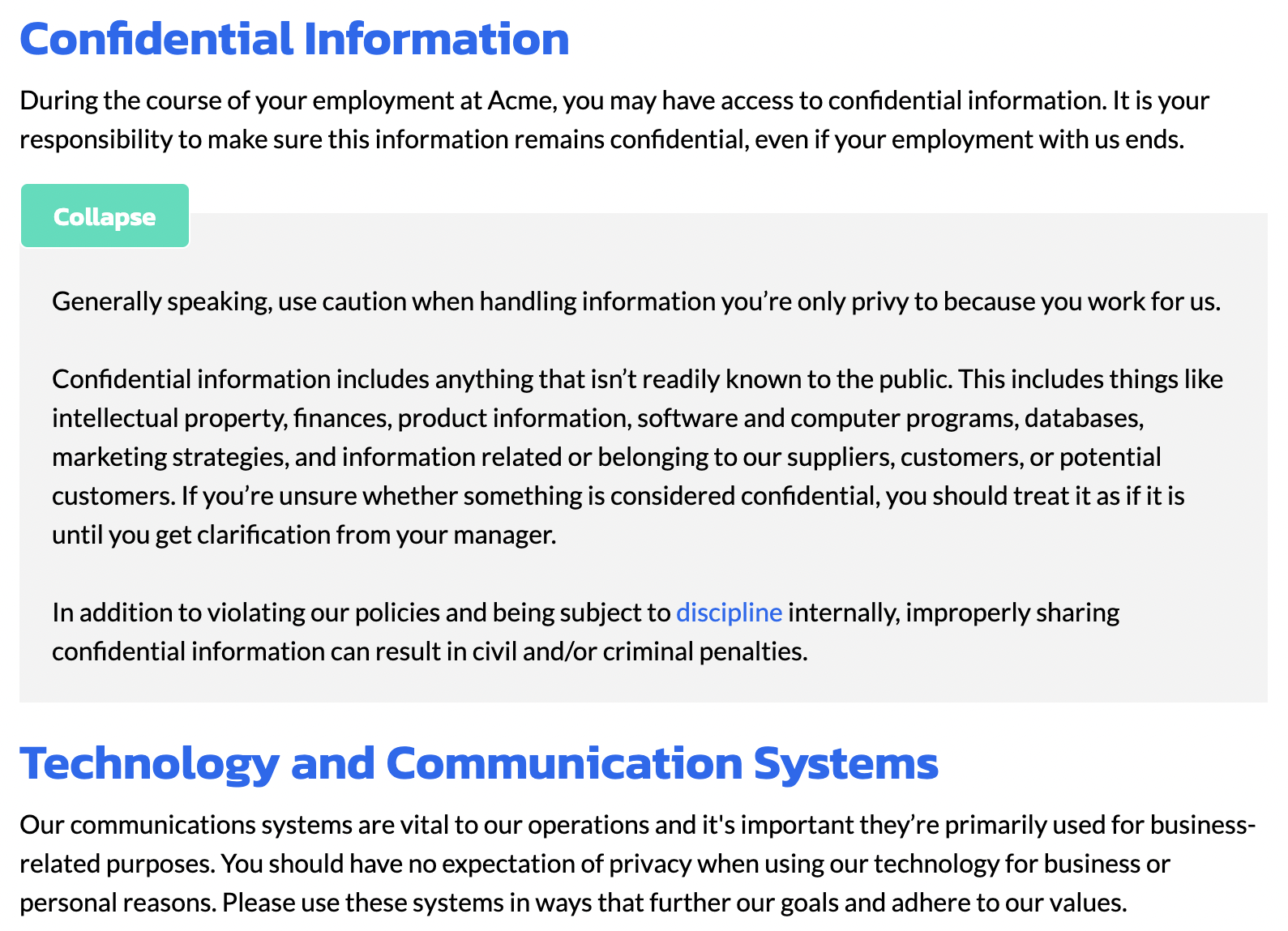
Intellectual property (protecting the employer and its clients)
Intellectual property involves protecting a company’s unique ideas and products, as well as those of its clients. Employers often create policies in line with these laws to protect their innovations and proprietary information, and employees are expected to follow these guidelines.
Insider trading
Laws on insider trading prevent individuals from using confidential company information to manipulate stock market transactions. These rules are essential for creating a fair marketplace, protecting investors, and maintaining trust in financial markets. It also ensures businesses and employees stay ethical and legal.
These laws are often covered alongside other financial topics such as bribery, gifts, and kickbacks within a code of conduct, code of ethics, fraud prevention, or other financial crime prevention policy.
Protected health information
This information is the personal health details that employers sometimes have access to. Relevant laws require employers to keep employees’ personal health information private and to share it with proper authorization only. This maintains employee privacy and trust.
These laws are usually covered in a privacy notice or personnel records policy.
Reviewing and Updating Your Employee Handbook
An effective employee handbook not only requires careful creation but also regular updates to stay relevant and compliant. Here’s how you can achieve that.
Involve your legal counsel for review and compliance
Always have a legal professional review your handbook. While you understand your company well, they ensure your policies are both fair and lawful, protecting your organization from potential legal challenges.
Even if you get content from a lawyer, they may not be your lawyer, so it’s best to review your policies at least annually with your legal counsel.
Ensure clarity and consistency in policies
Policies need to be plain, straightforward, and jargon-free. It’s not just about employees understanding them but about protecting your organization too.
Importance of regular updates and revisions
Laws change, as well as company cultures and technologies. Regularly revisit and revise your handbook to keep it current and in sync with any new legal and organizational changes. An up-to-date handbook ensures an organization that is adaptive and attuned to its time and its people.
Need help keeping your content up-to-date with changing laws? We can help with law change alerts and handbook maintenance services. Contact us.
Our Policies & Procedures Workbook helps you know everything you need to consider when making major employee handbook updates. Grab your copy here!

Final Thoughts
Handling the creation and maintenance of a successful employee handbook can be challenging but worth it. To create a successful employee handbook, focus on simplicity, clarity, and legal compliance. Always remember to keep it updated and aligned with the law, not just during the initial creation.
Blissbook is here to make things way easier! Creating a pixel perfect handbook doesn’t have to be overwhelming. Blissbook gives you a simple way to get it done right, covering all the complex parts like legal matters, clear policies, and design.
Want to see Blissbook for yourself? Request a demo and we’ll help you get your handbook sorted. It’s time to create something that will guide your team clearly and keep your business on the safe side, now and in the future.